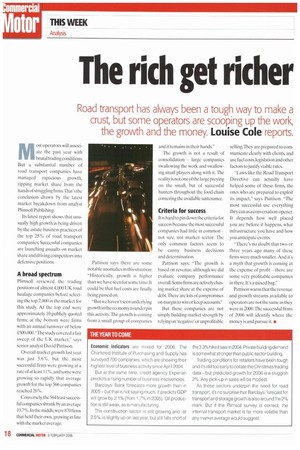The rich get richer
Page 18

If you've noticed an error in this article please click here to report it so we can fix it.
Road transport has always been a tough way to make a crust, but some operators are scooping up the work, the growth and the money. Louise Cole reports.
Most operators will associate the past year with brutal trading conditions. But a substantial number of road transport companies have managed rapacious growth, ripping market share from the hands of strugglingfirms.That's the conclusion drawn by the latest market breakdown from analyst Plimsoll Publishing.
Its latest report shows that unusually high growth is being driven by the astute business practices of the top 25% of road transport companies. Successful companies are launching assaults on market share and driving competitors into defensive positions.
A broad spectrum Plimsoll reviewed the trading positions of almost 4,0(X) UK road haulage companies before selecting the top 2,000 in the market for this study. At the top end were approximately 10 publicly quoted firms; at the bottom were firms with an annual turnover of below £500,000. The study covered a fair sweep of the UK market," says senior analyst David Pattison.
Overall market growth last year was just 5.6%, but the most successful firms were growing at a rate of at least 11 %.and some were growing so rapidly that average growth for the top 566 companies reached 26%.
Conversely, the 564 least successful companies shrank by an average 10.7%. In the middle were 870 firms that held their own, growing in line with the market average. Pattison says there are some notable anomalies in this situation: "Historically, growth is higher than we have seen for some time. It could be that fuel costs are finally being passed on.
"But we haven't seen underlying growth in the economy to underpin this activity. The growth is coming from a small group of companies and it remains in their hands."
The growth is not a result of consolidation large companies swallowing the work and swallowing small players along with it. The reality is not one of the large preying on the small, but of successful hunters throughout the food chain cornering the available sustenance.
Criteria for success
It is hard to pin down the criteria for success became the most successful companies had little in common not size, not market sector. The only common factors seem to be canny business decisions and determination.
Pattison says: "The growth is based on revenue, although we did evaluate company performance overall. Some firms are actively chasing market share at the expense of debt.There are lots of compromises on margin to win or keep accounts."
But these companies are not simply building market strength by relying on'negative' or unprofitable selling.They are prepared to communicate clearly with clients, and use fuel costs,legislation and other factors to justify viable rates.
-Laws like the Road Transport Directive can actually have helped some of these firms. the ones who are prepared to exploit its impact," says Pattison. "The most successful use everything they can as a conversation-opener. It depends how well placed you are before it happens, what infrastructure you have and how you anticipate events.
"There's no doubt that two or three years ago many of these firms were much smaller. And it's a myth that growth is coming at the expense of profit there are some very profitable companies in there. It's a mixed bag.
Pattison warns that the revenue and growth streams available to operators are not the same as they were in 2000.The successful firms of 2006 will identify where the money is and pursue it. •






































































































































































































